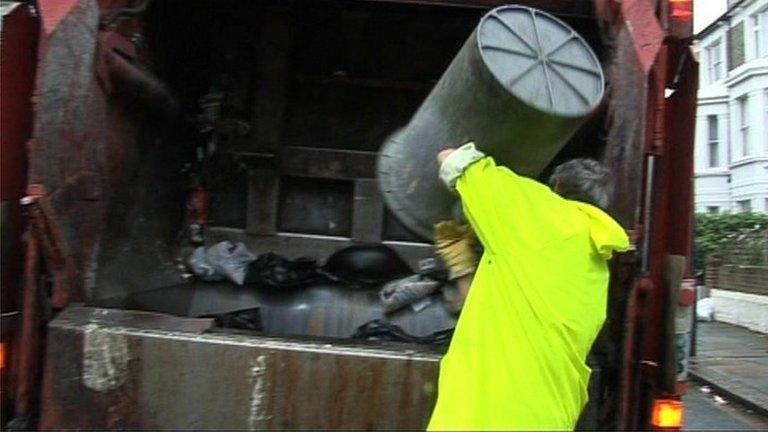Case for fewer councils is 'compelling', says minister
- Published
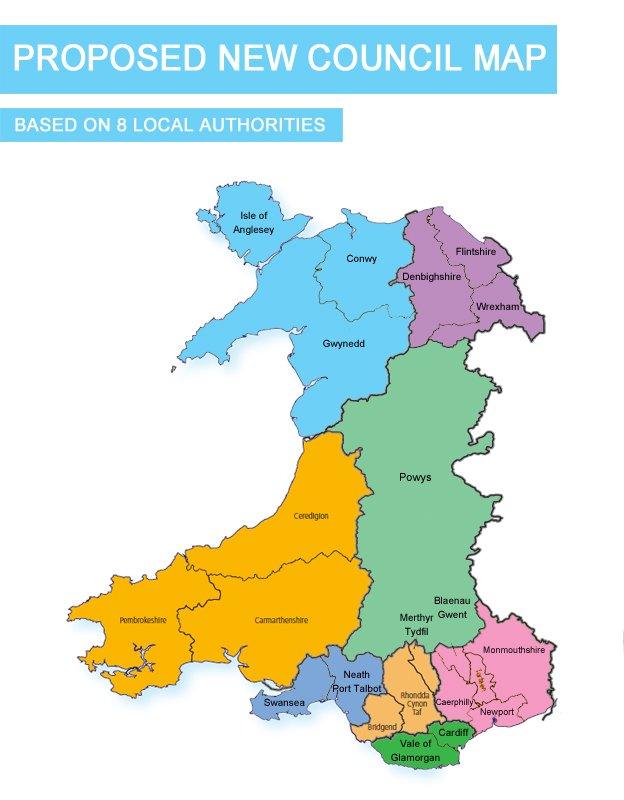
Reducing the number of councils in Wales from 22 to eight or nine would cut the cost of local government, the public services minister has said.
The proposals, by Leighton Andrews, to bring back bigger councils are broadly similar to pre-1996 arrangements.
Mr Andrews called the case for fewer local authorities "compelling".
However, the plans have been criticised by the body representing local authorities, some Labour council leaders and an ex-Labour minister.
Mr Andrews's blueprint envisages the return of historical counties such as Dyfed and West Glamorgan.
The proposals to bring back bigger councils are broadly similar to pre-1996 arrangements
Dyfed would be brought back by re-merging Carmarthenshire, Pembrokeshire and Ceredigion, and West Glamorgan would return by joining Swansea once more with Neath Port Talbot.
Cardiff would merge with the Vale of Glamorgan, while a merger between Caerphilly, Torfaen, Blaenau Gwent, Newport and Monmouthshire would create Wales' biggest council, with a population of nearly 600,000.
Bridgend would join Rhondda Cynon Taf and Merthyr Tydfil.
The minister will consult further on whether to move to two or three councils in north Wales.
Mr Andrews said it was important to get a council structure that could cope with future financial challenges
In the eight-council model, Anglesey, Gwynedd and Conwy would merge, as would Denbighshire, Wrexham and Flintshire.
The alternative would see Conwy and Denbighshire merging.
The cross-party Williams Commission, external advised against an eight-council structure, in January 2014, warning many gains from mergers would be "jeopardised or lost".
The report stated: "Such proposals would mean creating local authority areas like the whole of Gwent or the whole of north Wales. It would be very difficult to meet multiple diverse local needs effectively, or to maintain fair democratic representation within such areas."
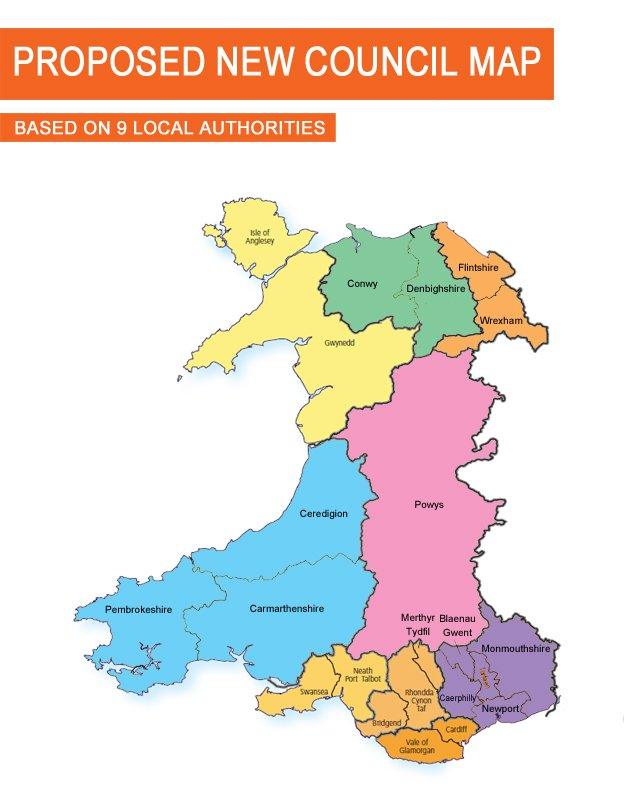
Mr Andrews has dropped plans to place "term-limits" on councillors, whereby an individual would only be able to serve for 25 years.
He is also proposing the current cap of 75 members per council be raised to a higher level.
In a written statement, Mr Andrews added: "I want to emphasise this is not a final decision. It is the next phase in discussions."
A draft bill will be published in the autumn but no changes will be made before next spring's assembly election.
Mr Andrews is confident his plans are on the right side of the political argument, despite criticism from senior Labour council figures.
He told BBC Wales: "Welsh Labour will be happy to go into the election next year campaigning to reduce the cost of politics and administration in local government."
'Issuing diktats'
But the Welsh Local Government Association (WLGA) dismissed the proposals, saying there was "no political consensus" on the future shape of councils, either across political parties in the assembly or between Welsh ministers and local authorities.
The WLGA called for an "urgent summit" of council leaders and the Welsh government.
The Afon Ganol was a county boundary between first Caernarfonshire and then Gwynedd on one side, and Denbighshire and Clwyd on the other, for 700 years
Association leader Bob Wellington, also the Labour leader of Torfaen council, said: "This summit could debate the way forward in terms of structures, but more importantly set in place a new vision for local government which is currently at the epicentre of public sector funding cuts and is having to carry a disproportionate share of the huge austerity burden."
There was fierce criticism of Blaenau Gwent's proposed merger with Caerphilly, Newport, Monmouthshire and Torfaen from its local Labour AM, a former environment minister.
Alun Davies said such changes would "only distract from the important issue of focusing on the challenges facing us as a borough".
Urging Welsh ministers to "listen and to reach out with meaningful discussions", he added: "Simply issuing diktats is the worst way to promote debate and discussion."
'Stitch-up'
Dominic MacAskill, from public services union Unison, said it would be "demanding that staff, our members, are put at the heart of considerations and that Welsh government commits to providing adequate funding for the transition costs of any restructuring".
Mr Andrew's proposals came under immediate fire from assembly opposition parties.
Conservative shadow local government minister Janet Finch-Saunders condemned what she called an "uninspiring map" chosen to "best serve the tribal party political interests of the Labour Party instead of ensuring proper local representation for families across Wales or delivering efficient local services".
Plaid Cymru's Rhodri Glyn Thomas welcomed the fact the Welsh government had "made clear its preferred map", but criticised the plans for not integrating health and social care.
Liberal Democrat AM Peter Black said "shoving together existing councils in a botched party-political stitch-up serves no-one aside from the Labour party".

PROPOSED EIGHT NEW COUNCILS
Gwynedd, Anglesey, Conwy*
Flintshire, Wrexham, Denbighshire*
Powys
Carmarthenshire, Pembrokeshire, Ceredigion
Swansea, Neath Port Talbot
Bridgend, RCT, Merthyr Tydfil
Cardiff, Vale of Glamorgan
Caerphilly, Blaenau Gwent, Newport, Monmouthshire, Torfaen
* There could be further consultation on merging Conwy and Denbighshire to create an additional council in north Wales.

COUNCIL LEADERS' REACTION
Blaenau Gwent: Labour leader Hedley McCarthy said it appeared "we are to be the periphery of a new mega-council which will be distant and remote from the people it is supposed to serve".
Denbighshire: Independent council leader Hugh Evans said the authority was "unclear about what, if any, review has led to the current proposed map".
But he said a possible consultation on combining Denbighshire with Conwy, rather than with Flintshire and Wrexham, deserved "serious consideration".
Gwynedd: Dyfed Edwards, a Plaid Cymru councillor, told BBC Radio Wales: "I do think in the north, dividing along north east and north west is right. I think two authorities is enough for the north."
Monmouthshire: Conservative Peter Fox accepted the need for some reform but expressed disappointment.
He said: "We're back to the future it looks like. I believe in local identity and local decision making, I believe that's really important to people."
Pembrokeshire: Independent council leader Jamie Adams said he was worried about the "obvious loss of local decision-making and accountability" and the "real damage reorganisation could do to a very successful brand".
"I am referring to the Pembrokeshire name, which is instantly recognisable to those living far outside our county and even beyond Wales," he said.
Rhondda Cynon Taf: Labour council leader Andrew Morgan said: "All council leaders will now need to consider the detail of the Welsh government's proposed map; I personally will want to remain focused on protecting the interests of services we provide to the communities we represent currently and the staff we employ to deliver them."
Swansea: Labour council leader Rob Stewart said he did not think the planned merger with Neath Port Talbot held "any fear" for the two authorities.
He said: "We already work as a city region. Swansea is undoubtedly the capital of that region but it doesn't mean people in other parts of the region should worry."
Vale of Glamorgan: Labour council leader Neil Moore said a plan for a voluntary merger involving his authority and Bridgend was turned down in January because it would cross a local health board boundary.
He called it "bizarre" and "galling" for Mr Andrews to now want Bridgend to join Merthyr and Rhondda Cynon Taf across another local health board boundary.

ANALYSIS BY VAUGHAN RODERICK
The third shake up in Welsh local government in 40 years would see the return of some familiar borders and names, the new all-purpose authorities roughly matching the eight counties which formed the upper tier of Welsh councils until 1996.
While some will welcome the return of historical names like Gwent and Dyfed - others would mourn the passing of the equally historic names like Pembrokeshire and Monmouthshire.
While sentiment may fire opposition to the changes in some areas, other will claim that the new authorities could prove remote and that any change would be a distraction at a time when local government is under severe financial pressure.
Meanwhile the issue is likely to figure heavily in next year's assembly election, with all three opposition parties opposing the government's map.

THE CHANGING FACE OF WALES
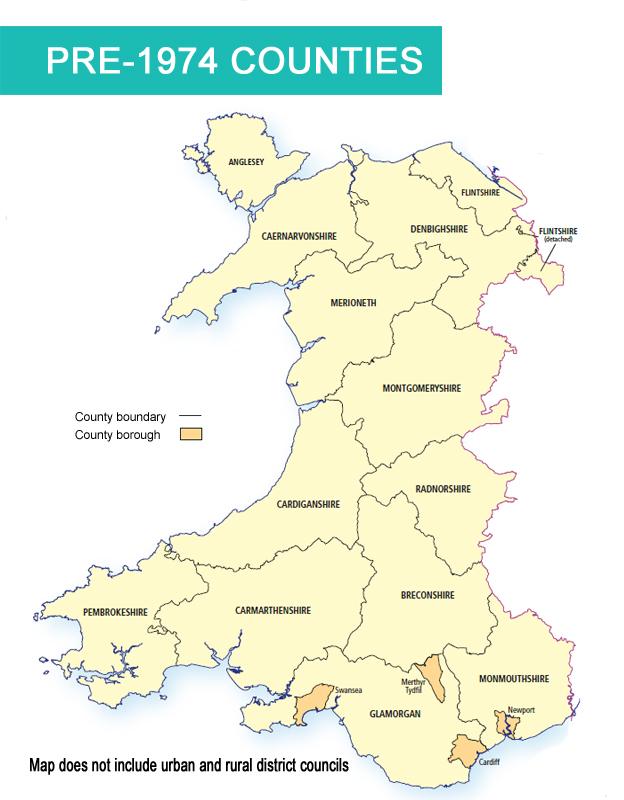
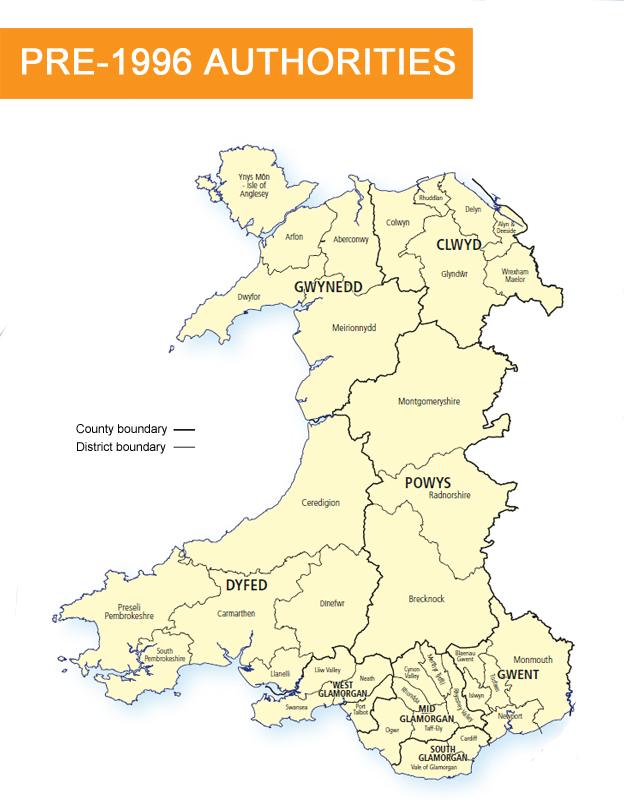
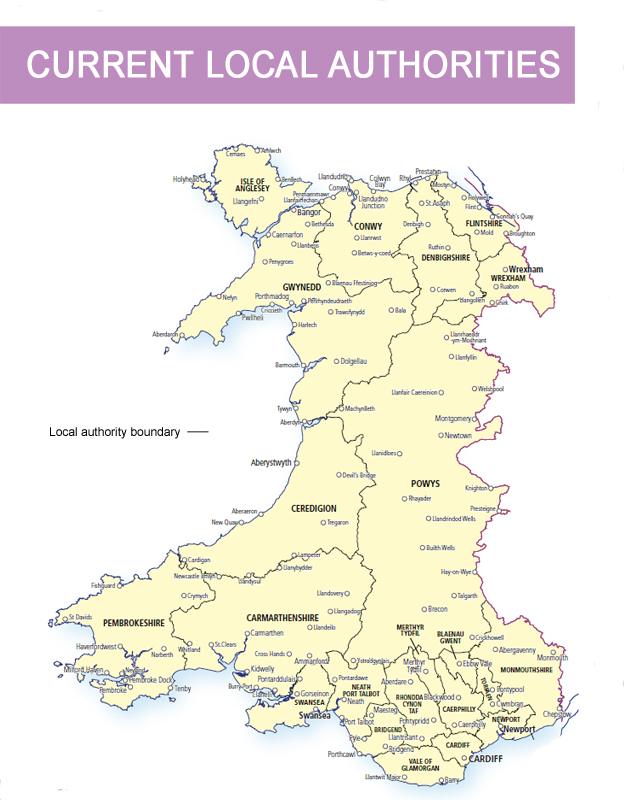
- Published17 June 2015
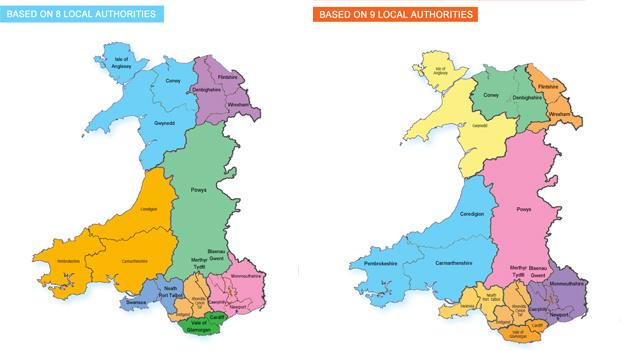
- Published16 June 2015

- Published15 June 2015

- Published14 June 2015

- Published11 June 2015
